One of my favorite Spring-flowering trees is Magnolia Jane. It’s easy to grow, reliably hardy even through tough Winters, and puts on quite a show almost year-round. Here’s why you absolutely need at least one Magnolia Jane in your garden.
We purchased three small Magnolia Jane shrubs years ago.
Of course this was before I began blogging, otherwise I would have filmed every moment of the purchase in pictures — which would have been hilarious, since we somehow stuffed those shrubs into our tiny Honda Fit car and didn’t lose so much as one leaf or blossom!
Here they are after planting, in April 2010:
(Again, pre-blogging photo, otherwise my husband and I joke that I would have needed every soil and mulch bag removed in order to take pretty pictures! Hah!)
July 2017 Editor’s Note: I have a new post on how our Magnolia Janes look in the Summer months. The link is at the bottom of this post!
We planted the Magnolia Jane shrubs in our backyard before we even knew what we wanted to do with our backyard. We had an “L” of Arborvitaes along the right-hand back corner of our fence. (I know – very traditional, but I’ve grown to love how it looks.)
On the side of the yard, we had transplanted a Dappled Willow from the front yard — a rookie mistake which ended up being an awesome mistake because we love how our Dappled Willow “wall” looks now! (Read about my Dappled Willow rookie mistake and the awesome result here.)
In between the Arborvitaes and the Dappled Willow there was “some space” left over, so that’s where we planted the Magnolia Jane shrubs. (See what I mean about not really having a plan yet?)
The Magnolia Jane shrubs were multi-stemmed, and I knew I wanted them to grow beyond shrub size into tree size.
In just two years, these Magnolia Jane shrubs went from 5′ at their tallest point when we purchased them to 7+’ at their tallest point:
I’m keeping them as multi-stemmed trees, and rarely prune off any branches growing completely horizontal instead of up. (I might have done this twice.) Otherwise, I don’t need to do much for them to maintain their pretty vase shape.
Our Magnolia Jane trees are the earliest of the Spring-flowering trees to bloom each April. The blooms first appear before any leaves are on the tree, but the minute those blooms begin opening, bright green leaves start popping out!
And when you find the perfect Magnolia Jane flower blossom? Time stops and you enjoy it.
And then you take a picture to share:
Gorgeous, right? You can have these moments too. I’m telling you: plant one of these trees. You need to. You’ll thank me. You’re welcome.
Here’s what our Magnolia Jane trees look like in Winter. The two trees on the left are Magnolia Janes. The reddish colored twigs on the shrubs to the right of them are Dappled Willow. It’s a pretty contrast of grey branches and reddish branches against the white fence. (And sometimes against the white snow too, if I’m lucky here in southern New Jersey.)
As the Winter season marches on, little catkins develop — at least that’s what I call them — that look like giant pussy willows. By the early Spring, they look like this:
(Again, the branches to the right of the Magnolia Janes are from the Dappled Willow shrubs.)
The photo above was taken on April 6, 2014. The next photo below was taken just a couple of weeks later, on April 24, 2014:
Magnolia Jane details:
- Can be grown as a shrub or tree, or even a flowering hedge
- Tulip-shaped flowers bloom in a pretty fuchsia-purple shade
- Flowers are sterile, no worries about seeds falling or seedlings popping up
- Spring flowers, although you might get lucky and have a few blooms pop up during the Summer
- Summer leaves are rounded and a rich green shade
- Fall leaf color is yellow turning to copper before falling
- USDA Zones 4 – 8
- Deciduous – i.e. not evergreen
- Low maintenance once established
- Full sun to part shade;
- Average-to-moist soil, on the acidic side
- Average height is 10′ to 15′ and the spread can be 8′ to 12′ – perfect for smaller gardens and yards
When first planting your Magnolia Jane, add some leaf compost to the planting hole, and mix in a bit of a soil acidifier into the soil around the tree. A layer of mulch is good, but don’t put the mulch right up against the base of the tree, leave a bit of room around the base. (An inch or more is just fine.)
For the first few years, we had to water our Magnolia Jane trees a lot. At least it sure felt like it. But our Summers tend to get hot and humid quickly and I honestly think it took our Magnolia Janes at least two full seasons until they were happy and not needing any tender loving care.
Ongoing care of your Magnolia Jane: Each Spring, add some compost to your garden soil around the trees, and mix in an organic fertilizer according to package directions, depending on what brand you use. (I use Holly Tone — click here to read about it on Amazon.) Normally no pruning is necessary, unless you need to remove a random branch or two for shaping. If you do feel the need to remove any branches, wait until after Magnolia Jane has finished blooming in the Spring. (This year’s flower buds grow on last year’s wood, so anything you remove late in the Summer will potentially be removing next year’s flowers too.)
For the last few years, the care for our Magnolia Jane trees has been minimal now that they are established and happy. Whoo hoo!
How do our Magnolia Janes look now – in 2016?
The three images above – of the different stages of a Magnolia Jane flower opening – I took on March 30, 2016.
Our Magnolia Jane trees are at least 10 feet tall now.
I was very excited to snap pictures this year, especially as I was preparing this post for you.
I knew I’d just have to wait another week or so, to share the beautiful show with all of you. Because one of the things you’ll read about Magnolia Jane trees is that because their blooms arrive in mid-Spring, they usually avoid any frost damage as can occur with earlier blooming Magnolias like the Star Magnolia.
So guess what happened?
We’ve had a series of below-freezing temperatures almost every night this week. And rain. Here’s what the flowers look like today:
Yes, I almost cried this morning.
There were actual tears forming in my eyes as I just stood there, almost defeated.
Until I stepped back and examined the trees a bit more and saw this:
Yes, it’s another frost-damaged flower blossom, but look what’s in the background: several yet-to-be-opened flowers!
That’s the beauty of nature: even the predictable plants can be unpredictable because Mother Nature likes to mix it up.
We’re supposed to get a coating of snow tomorrow. Sigh.
I’ll be inside cheering the remaining Magnolia Jane blossoms to hang in there!
Updated, July 2017:
Want to see how our Magnolia Jane trees look in the Summer? Click here or on the image below for my new post!
Happy gardening!
~Laura

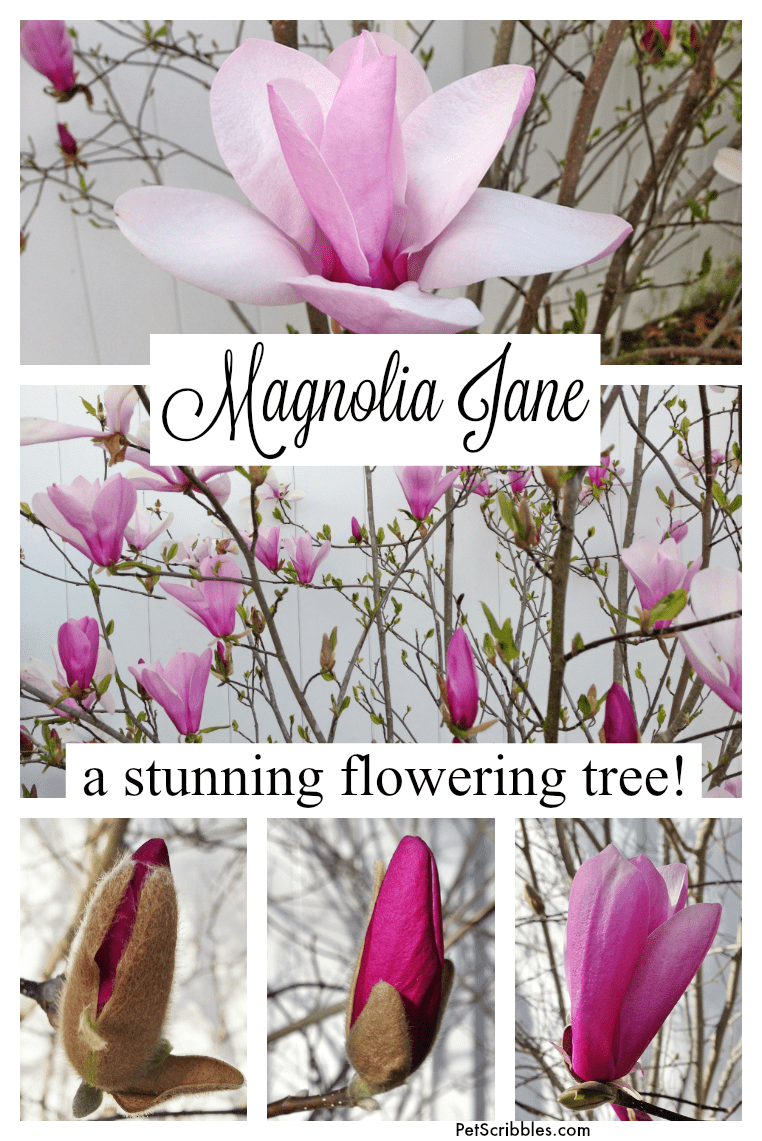
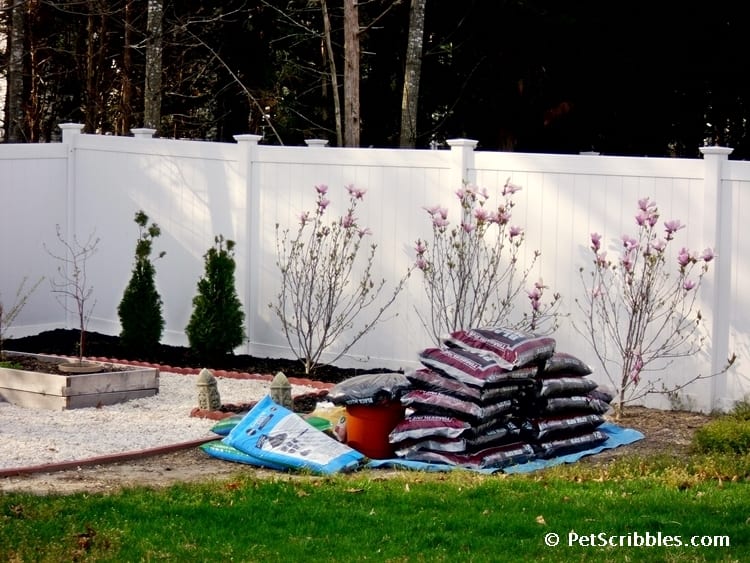
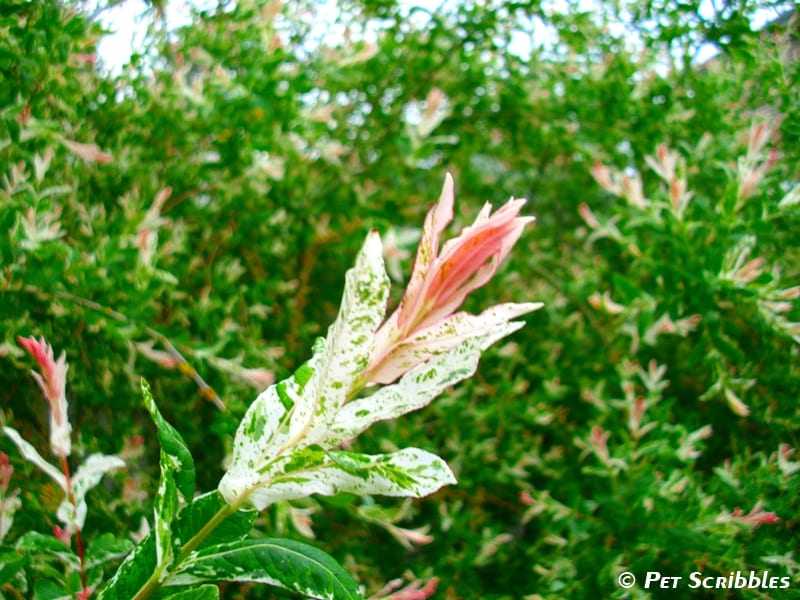
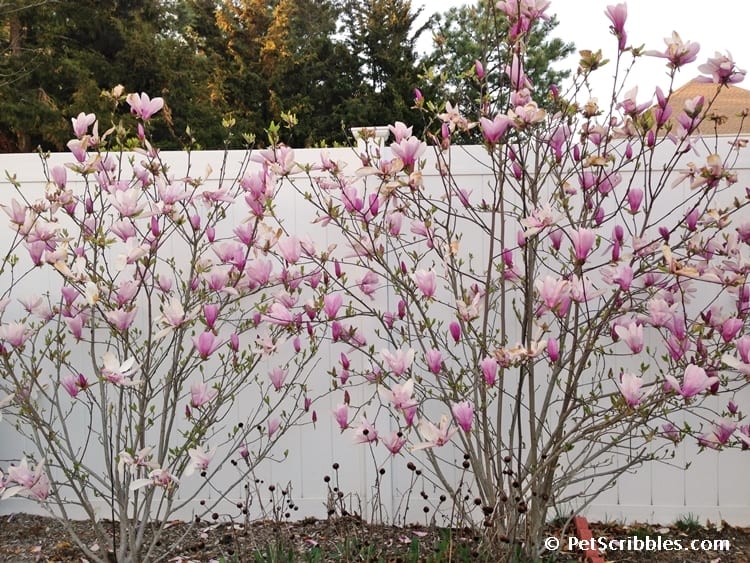
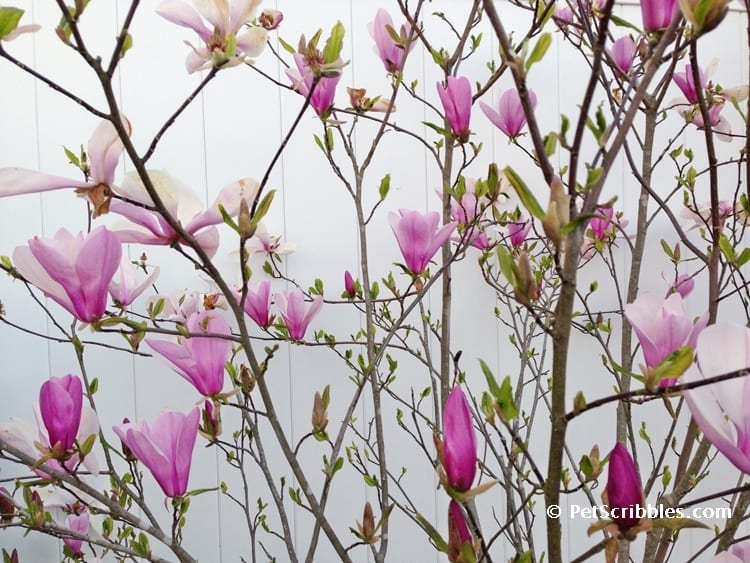
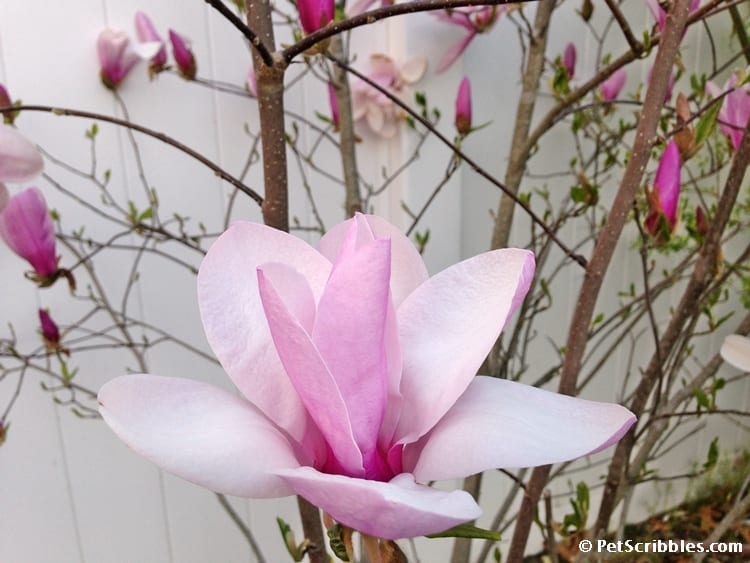
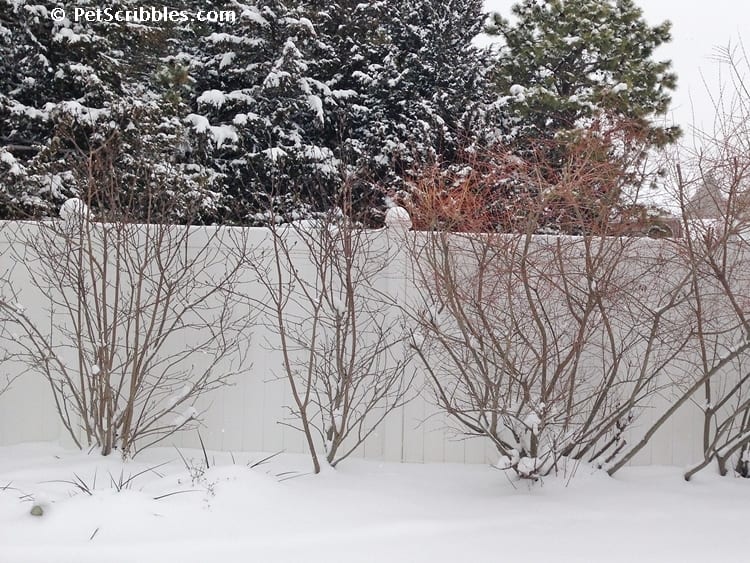
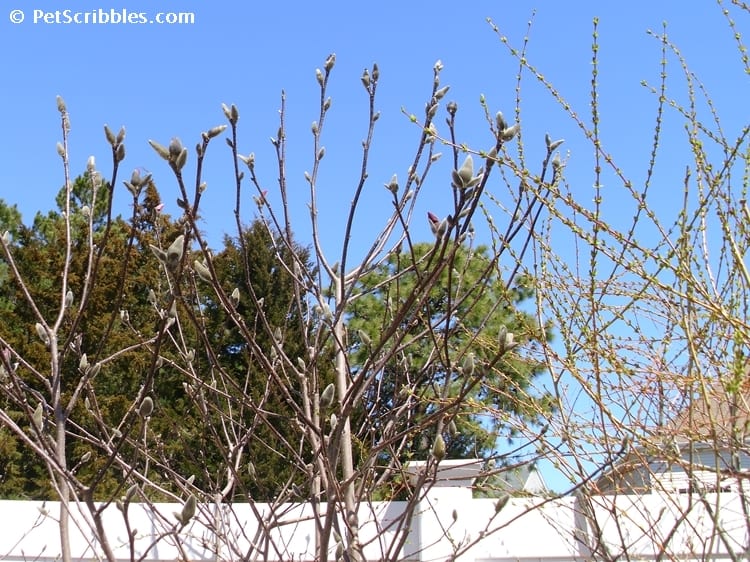
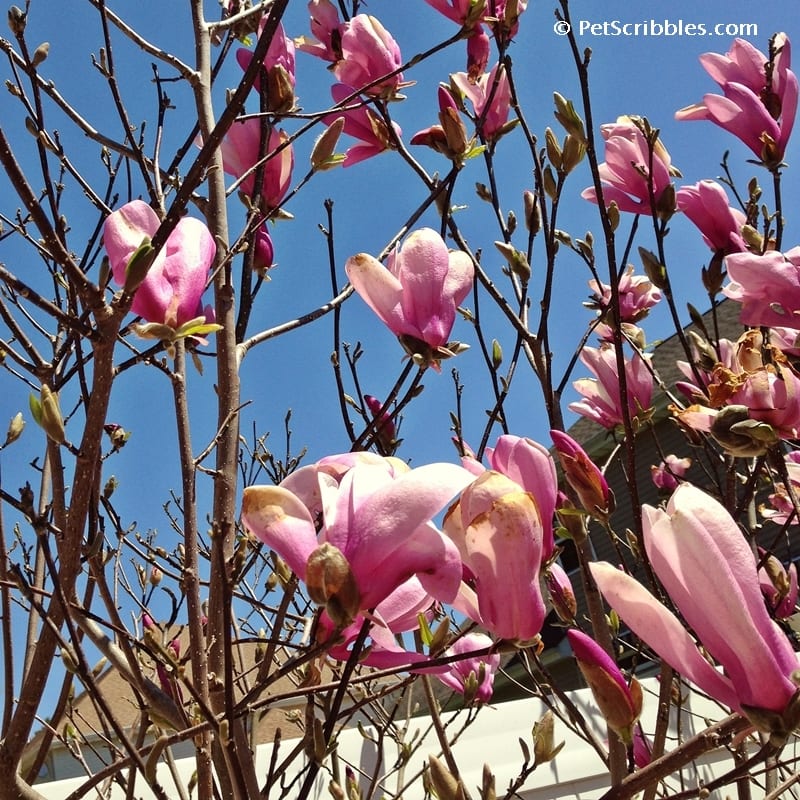
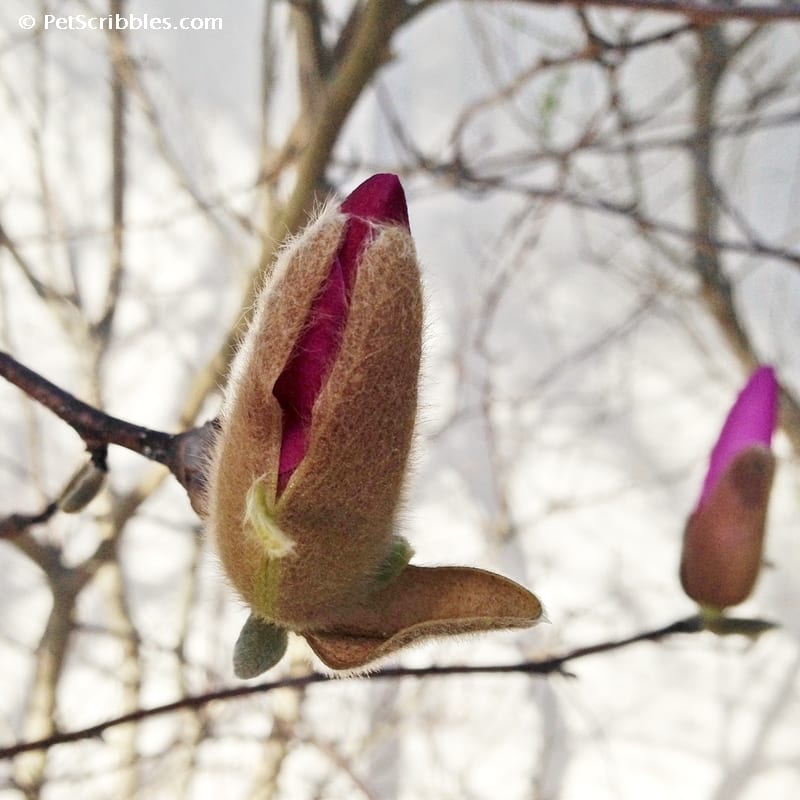
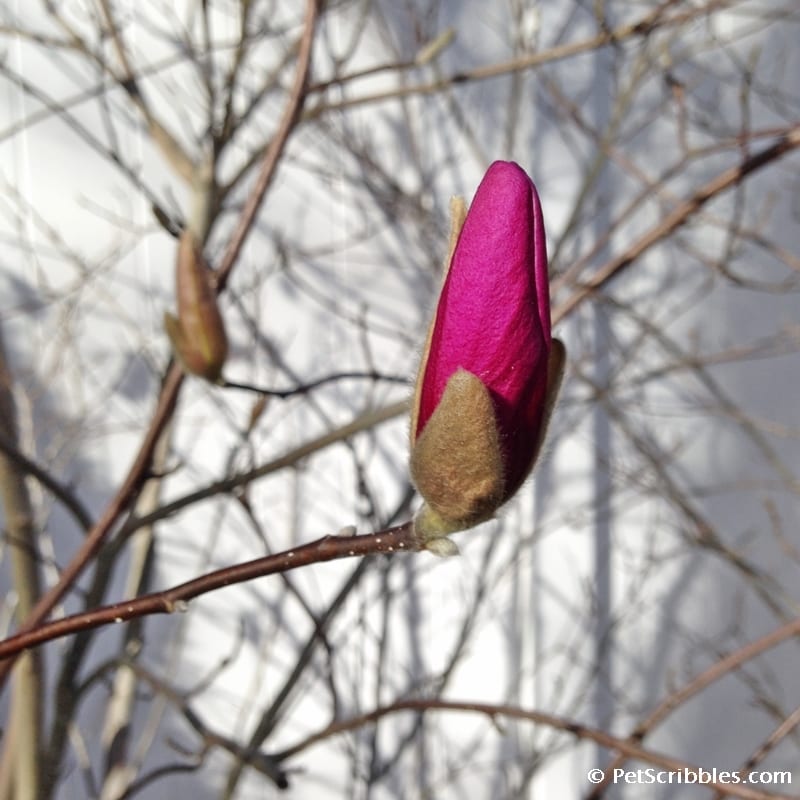
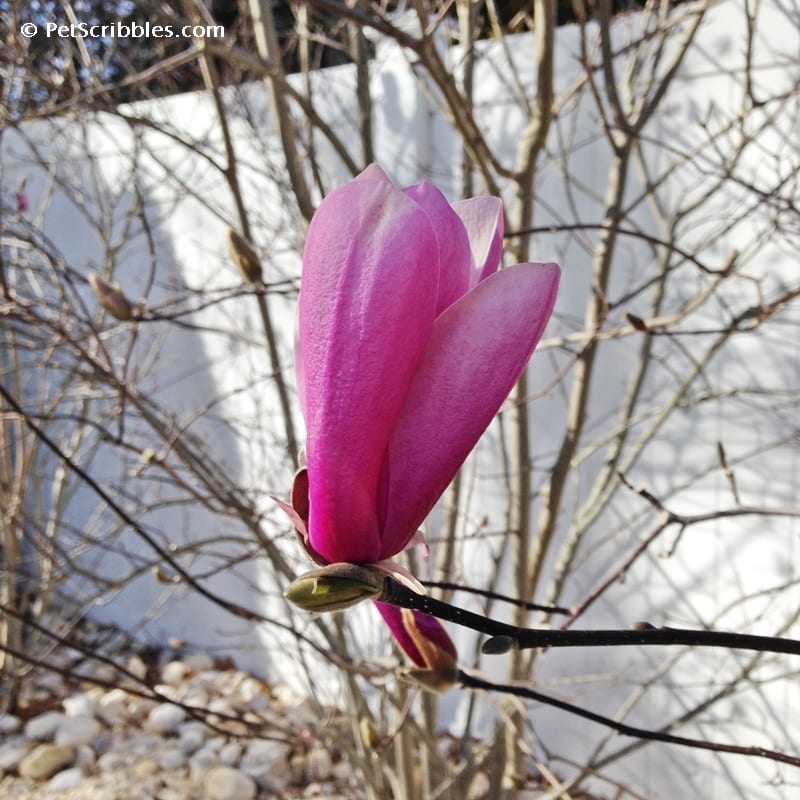
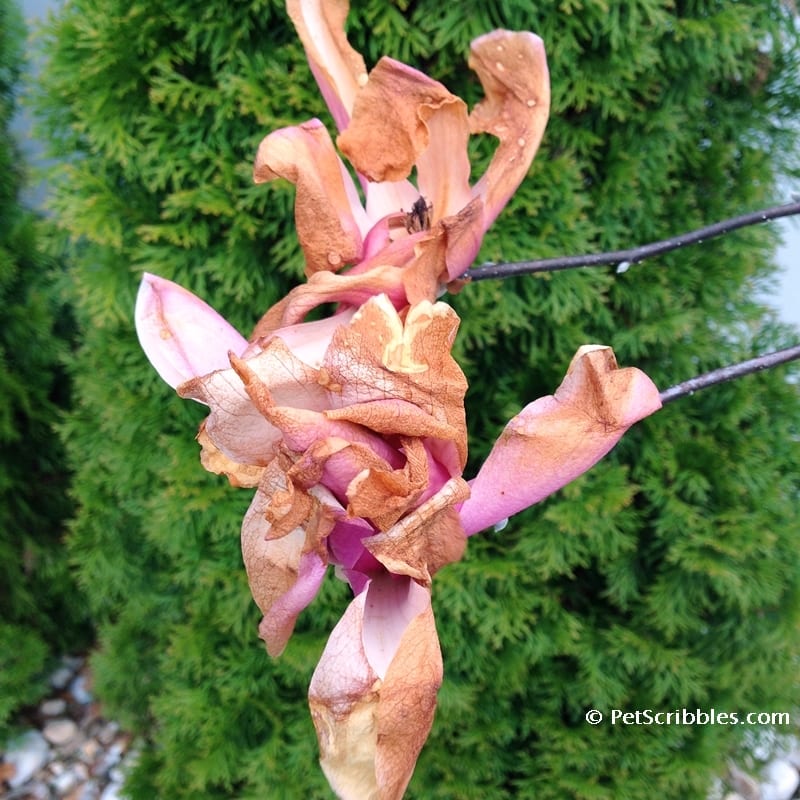
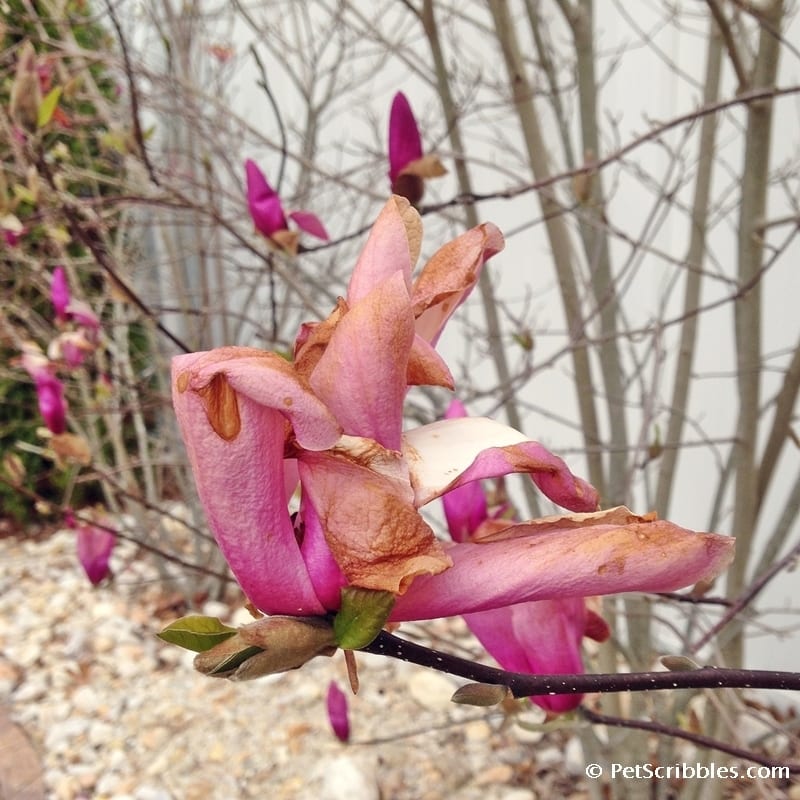

Ohhh I love those beautiful trees/shrubs. Those blooms are just gorgeous. They are : also the very first thing that blooms here in Texas. I had no idea what they so we just referred to them as tulip trees. Lovely lovely pictures. Know you were crushed when the freeze came. Enjoyed reading about these so very much. Thank you
Glad I could help Ann! Texas also has a favorite tree of mine that is treasured up here in New Jersey: the Crepe Myrtle! It’s treasured up here because there’s no guarantee — due to the Winters — how Crepe Myrtles will look year to year. They aren’t easy to grow up here. (But once I saw them in Texas while visiting friends, I had to try! My Texan friends were surprised I was so over-the-moon about Crepe Myrtles, because they’re everywhere apparently in your neck of the woods!) We’ve got two in our front yard. I even put one as the main focal point in the center garden bed in front. However, last year’s blooms were a bit on the “meh” side – not spectacular at all. But I’m hopeful once it gets established more. Fingers and paws crossed!
Luara, I really would love to see a photo of you’re Jane trees/shrubs now that they are 10ft. I have one that I planted in my front yard which I’m hoping will be more like a tree. Ive been looking online and see so many different photos and photos describing them as shrubs and some describing them trees. I really would like to know if they grow more like trees or shrubs and I think a photo from someone who is not trying to sell one would be a more honest representation. Sooo photo please!! Thank you in advance.
Your wish is my command, Jane! Or should I say: better late than never? It took me awhile, but I didn’t forget! I’ve got a new Magnolia Jane post up here: https://www.petscribbles.com/2017/07/magnolia-jane-in-the-summer.html
Enjoy!
Hello,
Will Jane Magnolia trees ruin foundation if planted next to a house? Pros & Cons. Regards
I don’t think they would, however, without knowing anything about your foundation, yard, climate, etc., I’m not able to provide you with pros and cons — other than to get the best advice, ask your local garden nursery experts. Take a picture of the area you’d like to plant a Magnolia Jane with you — perhaps on your mobile phone, as that will help the local garden experts to help you!